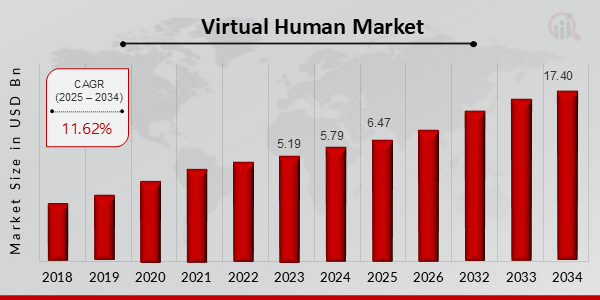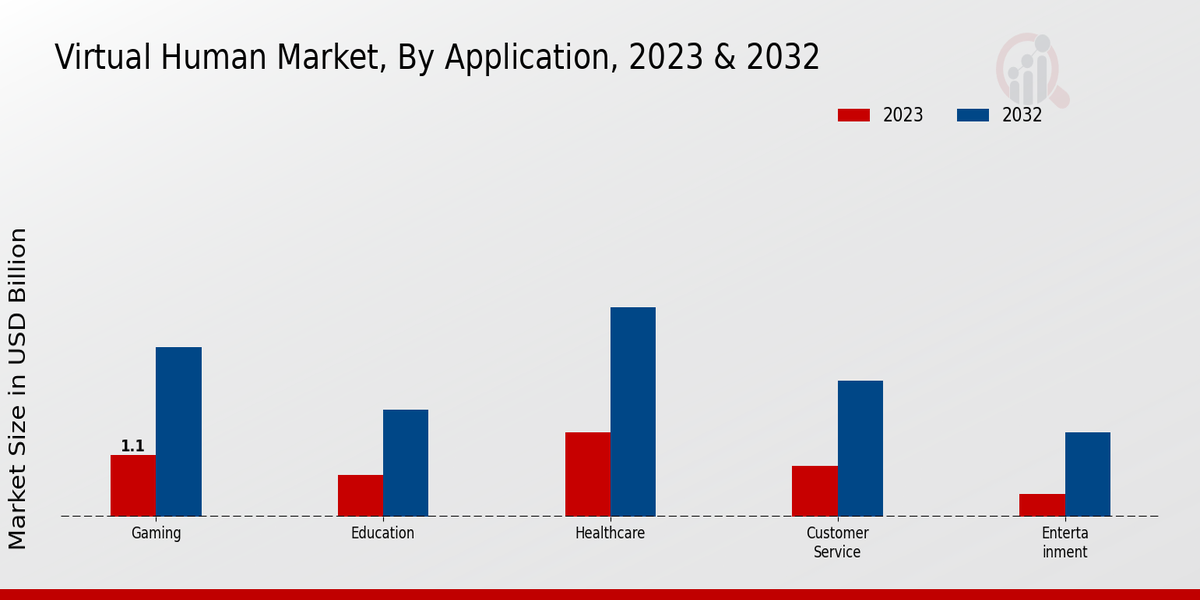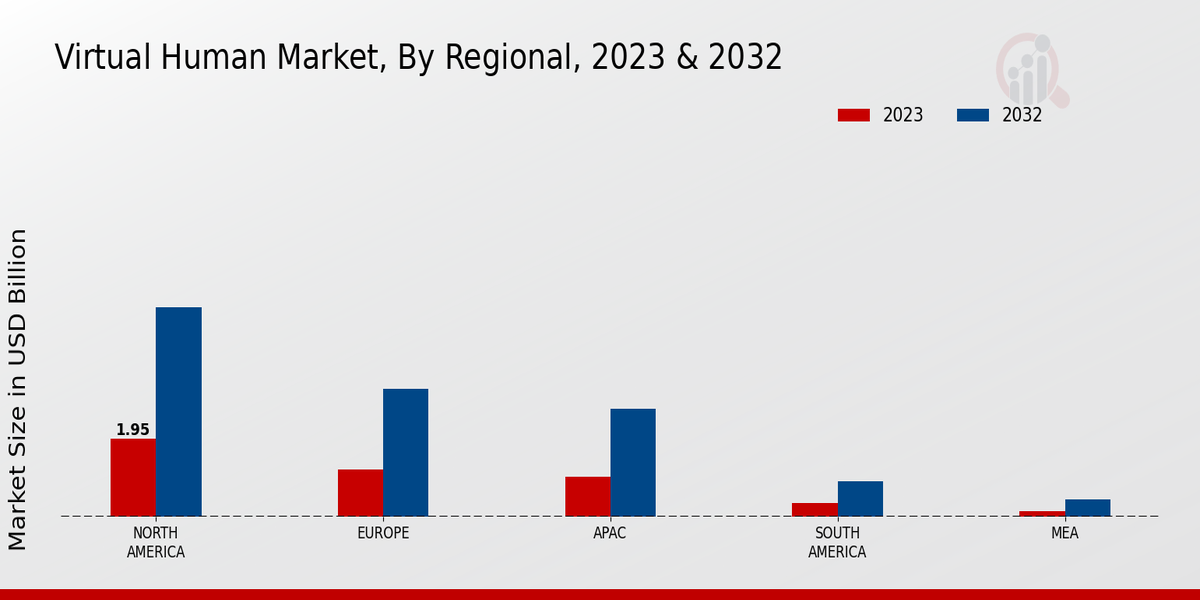Virtual Human Market Overview
Virtual Human Market is projected to grow from USD 6.47 Billion in 2025 to USD 17.40 Billion by 2034, exhibiting a compound annual growth rate (CAGR) of 11.62% during the forecast period (2025 - 2034).
Additionally, the market size for Virtual Human Market was valued at USD 5.79 billion in 2024.
Key Virtual Human Market Trends Highlighted
The Virtual Human Market is witnessing significant growth driven by advancements in artificial intelligence and machine learning technologies. These key developments enable the creation of more realistic and interactive virtual humans that enhance user engagement across various sectors, including entertainment, customer service, education, and healthcare. As businesses increasingly adopt these virtual assistants and avatars in their operations, the demand for sophisticated virtual human solutions continues to rise, offering businesses a competitive edge while improving customer experiences.
There are notable opportunities to be explored in the areas of virtual reality and augmented reality, where virtual humans can provide immersive experiences.Furthermore, the increasing acceptance of virtual influencers in marketing and brand promotion presents a unique opportunity for organizations to tap into new audiences.
Companies can leverage these technologies in personalized marketing strategies, fostering deeper connections with consumers. This emerging landscape is ripe for innovation as businesses look to harness the power of virtual humans to improve interactions and enhance overall productivity. In recent times, trends such as the integration of virtual humans into social media platforms and the rise of virtual reality events have gained traction. These trends indicate a shift in consumer preferences toward more interactive and engaging digital experiences.As virtual humans become more prevalent in educational settings, there is a growing interest in their role in delivering personalized learning experiences.
Moreover, the expansion of remote working environments has further increased the relevance of virtual humans in facilitating communication and collaboration among teams. The ongoing evolution of this market reflects the broader shift toward digitalization and offers exciting possibilities for future growth.
Figure 1: Virtual Human Market size 2025-2034

Source: Primary Research, Secondary Research, MRFR Database and Analyst Review
Virtual Human Market Drivers
Growing Demand for Virtual Interactions
The increasing reliance on digital interfaces and virtual interactions has catalyzed a significant shift in various sectors, particularly in the Virtual Human Market Industry. As businesses and consumers increasingly adopt virtual modes of communication, there is a corresponding rise in the demand for realistic virtual human avatars that can simulate human interaction. This demand extends beyond gaming and entertainment, encompassing fields such as education, healthcare, and customer service.In educational settings, virtual humans can serve as teaching assistants, providing personalized learning experiences to students that traditional teaching methods may not offer.
In the healthcare sector, virtual humans are being utilized for telemedicine, allowing healthcare professionals to interact with patients remotely, thus enhancing accessibility and efficiency. The Virtual Human Market Industry is further buoyed by the need for companies to create engaging and interactive customer experiences.As a result, businesses are investing in sophisticated virtual human technologies that can simulate real human behavior and enhance user engagement. The implications of this growing demand are profound, indicating that virtual humans will play an increasingly central role in shaping how we communicate, learn, and interact in both personal and professional spheres.
Advancements in AI and Machine Learning
The rapid evolution of artificial intelligence (AI) and machine learning technologies is significantly driving growth in the Virtual Human Market Industry. These advanced technologies allow for the creation of hyper-realistic virtual humans that are capable of understanding and responding to complex human emotions and queries in real-time. AI-driven virtual humans can enhance customer support services, providing instant assistance and improving customer satisfaction levels.As these AI technologies become more sophisticated, they empower virtual humans to learn from interactions, refine their responses, and adapt to user preferences, making them increasingly valuable across various applications.
Expansion of the Gaming and Entertainment Sector
The booming gaming and entertainment sector plays a crucial role in propelling the Virtual Human Market Industry forward. As gamers and audiences seek more immersive and interactive experiences, the demand for virtual humans has surged significantly. These virtual beings not only enhance gameplay but also create unique storytelling experiences, drawing in viewers and players alike.
The industry's continuous investment in innovative gaming technologies reinforces the necessity for realistic virtual humans, as developers aim to attract a larger audience base and maintain engagement.Furthermore, virtual reality (VR) and augmented reality (AR) technologies are becoming more prevalent, offering gaming experiences that are more lifelike than ever, thus catalyzing the growth of the Virtual Human Market Industry.
Virtual Human Market Segment Insights
Virtual Human Market Application Insights
The Application segment of the Virtual Human Market showcases robust growth dynamics, with the overall market anticipated to reach a valuation of 4.65 USD Billion in 2023, progressively expanding to 12.5 USD Billion by 2032. This segment is propelled by diverse applications ranging from Gaming to Healthcare, each contributing to the market's upward trajectory. In 2023, the Gaming sector commanded a notable position with a valuation of 1.1 USD Billion, reflecting its significant role in consumer engagement and experience enhancement.
As public interest in interactive entertainment continues to grow, this segment is expected to see a surge to 3.0 USD Billion by 2032, establishing itself as a dominant force in the Virtual Human Market.The Education segment, valued at 0.75 USD Billion in 2023, underscores the increasing integration of virtual technology in learning environments as institutions seek innovative methods to engage students.
This segment is projected to grow to 1.9 USD Billion, driven by a demand for personalized learning experiences and scalable training solutions. In Healthcare, valued at 1.5 USD Billion in 2023, virtual humans present significant advancements in patient interaction and telehealth services.
The sector is expected to expand to 3.7 USD Billion, fueled by the rising need for accessibility and innovative treatment options, representing a vital application of virtual human technology.Meanwhile, the Customer Service segment, with a valuation of 0.9 USD Billion in 2023, is becoming increasingly significant as businesses turn to virtual humans to enhance customer interactions, reflecting a shift in service delivery models. This segment is predicted to reach 2.4 USD Billion, demonstrating the growing reliance on virtual solutions for improved service efficiency.
Lastly, the Entertainment sector, although the smallest with a valuation of 0.4 USD Billion in 2023, plays an essential role by offering immersive experiences in storytelling and content creation, with expectations to rise to 1.5 USD Billion by 2032 as demand for novel entertainment avenues continues to rise.Overall, the Virtual Human Market segmentation highlights a diverse landscape of applications driving forward-thinking solutions, with significant potential for growth across each category, revealing trends that align closely with technological advancements and consumer preferences.
The increasing adoption of Virtual Human technology across these domains reflects a broader market growth driven by the pursuit of enhanced interactivity and engagement in both personal and professional environments.

Source: Primary Research, Secondary Research, MRFR Database and Analyst Review
Virtual Human Market Technology Insights
The Virtual Human Market, valued at 4.65 billion USD in 2023, is witnessing significant growth driven by advancements in Technology. The market is expected to reach 12.5 billion USD by 2032, reflecting a robust interest in the integration of innovative technologies. Among these, Artificial Intelligence plays a crucial role in enhancing user interaction and personalization, while Augmented Reality is reshaping engagement by blending digital content with the real world.
Virtual Reality is pivotal in creating immersive experiences, dominating sectors such as gaming and training, and Mixed Reality emerges as a game-changer, enabling seamless interaction between real and virtual environments.Together, these technologies represent a substantial part of the Virtual Human Market segmentation, contributing to various applications across industries. Market growth is fueled by increasing demand for enhanced customer experiences, the growth of the gaming industry, and rising investments in related technologies, while challenges such as the need for high-quality content and technological limitations also persist.
The Virtual Human Market statistics reveal a vibrant landscape with numerous opportunities for innovation and expansion.
Virtual Human Market End Use Insights
The Virtual Human Market generated significant revenue in 2023, reflecting robust interest across various applications, particularly in the End Use segment. As this market evolves, it has been categorized into distinct areas, notably B2B and B2C sectors. The B2B space is gaining traction due to increasing demand for virtual humans in training simulations, customer service automation, and virtual assistance, facilitating enhanced business efficiency and engagement.
Meanwhile, the B2C segment is thriving as consumers embrace virtual experiences in gaming, online shopping, and social interaction, showcasing the evolving role of technology in daily life.These factors contribute to substantial growth opportunities within the Virtual Human Market, driven by advancements in artificial intelligence and immersive technologies. Furthermore, emerging trends indicate an increasing integration of virtual human solutions in various industries, underscoring the importance of understanding Virtual Human Market statistics and data for strategic planning. Overall, the encapsulated dynamics within these segments highlight avenues for innovation and investment, marking a transformative phase in the Virtual Human Market industry.
Virtual Human Market Deployment Model Insights
The Virtual Human Market, valued at 4.65 billion USD in 2023, encompasses a variety of deployment models, primarily focusing on Cloud and On-Premise solutions. Both deployment methods cater to unique business needs, with Cloud deployment gaining traction due to its flexibility, scalability, and cost-effectiveness, making it a preferred choice for many organizations. Conversely, On-Premise deployment offers enhanced security and control over sensitive data, appealing to industries with stringent regulatory requirements.
The market's growth is supported by the increasing demand for virtual human applications across sectors such as entertainment, health care, and education.However, challenges such as data privacy concerns and the requirement for robust infrastructure remain significant. The Virtual Human Market segmentation reflects an expanding interest in innovative virtual solutions, presenting new opportunities for developers and businesses. As the market evolves, businesses are expected to strategically evaluate their deployment models to align with technological advancements and consumer expectations, driving overall market growth.
Virtual Human Market Regional Insights
The Virtual Human Market is experiencing substantial growth driven by increasing demand for innovative technology solutions across various sectors. In 2023, North America will lead the market with a valuation of 1.95 USD Billion, expected to reach 5.25 USD Billion by 2032, showcasing its majority holding and significant influence on the overall market dynamics.
Europe follows with a valuation of 1.2 USD Billion in 2023 and projected growth to 3.2 USD Billion by 2032, marking it as a critical region for the development of virtual human technologies.The APAC region accounts for 1.0 USD Billion in 2023 and is anticipated to grow to 2.7 USD Billion, signifying its emerging role in the Virtual Human Market. South America and MEA represent smaller yet important segments, with valuations of 0.35 USD Billion and 0.15 USD Billion in 2023, respectively, growing to 0.9 USD Billion and 0.45 USD Billion by 2032.
The market growth across these regional segments is driven by advancements in AI and machine learning, promising opportunities for further expansion and innovation.

Source: Primary Research, Secondary Research, MRFR Database and Analyst Review
Virtual Human Market Key Players and Competitive Insights
The Virtual Human Market is an evolving sector characterized by innovation and diversity, driven by advancements in artificial intelligence, machine learning, and graphics technology. As industries increasingly integrate virtual humans into various applications, including customer service, gaming, education, and entertainment, understanding the competitive landscape becomes essential. Companies are employing strategic partnerships, investing in research and development, and focusing on user experience to ensure they remain at the forefront of this dynamic market. The competitive insights within this arena highlight the importance of technological proficiency and the ability to adapt quickly to changing consumer demands and market trends.
As virtual humans redefine interaction across digital platforms, the competition intensifies, revealing unique strengths and market positioning for firms operating in this space.Microsoft has established a significant presence in the Virtual Human Market through its robust technological infrastructure and comprehensive software offerings.
By leveraging its strong brand equity and vast resources, Microsoft excels in creating intuitive and scalable virtual human solutions that cater to a wide array of industries. Their strengths lie in advanced AI algorithms and superior data analytics capabilities, which empower businesses to enhance customer engagement through lifelike virtual beings. Moreover, Microsoft's commitment to research and innovation ensures that its products remain competitive and aligned with industry standards.
Their strategic collaborations and extensive ecosystem further bolster their position as they expand the boundaries of what virtual humans can accomplish in various operational contexts.Reallusion is another key player in the Virtual Human Market, known for its user-friendly tools that empower creators to develop engaging virtual characters efficiently.
The company's strengths are evident in its comprehensive suite of software solutions designed for animation and character creation, which allows users to produce high-quality virtual humans without extensive technical know-how. Reallusion's emphasis on accessibility and community engagement has fostered a strong user base, benefiting from the ability to create customized virtual humans tailored to specific needs. Additionally, the company's commitment to regular updates and feature enhancements demonstrates its responsiveness to market demands, enabling users to leverage the latest advancements in virtual human technology.
This focus positions Reallusion as a competitive force, particularly among creators seeking innovative and versatile character-building solutions in the digital sphere.
Key Companies in the Virtual Human Market Include
Virtual Human Market Industry Developments
The Virtual Human Market has seen significant movements in recent months. Microsoft continues to invest heavily in virtual human technologies, enhancing its platform to support immersive experiences. Reallusion has introduced advanced animation tools, improving the creation of digital humans for various industries. Hour One is gaining attention for its innovative approach to generating lifelike avatars for customer service applications. IBM and NVIDIA are collaborating to integrate AI capabilities into virtual human interfaces, driving advancements in machine learning and interactive responses.
Companies like Unity Technologies and Epic Games are exploring virtual humans for gaming and entertainment, pushing the boundaries of realism in character design. The market is also witnessing consolidation, with Meta acquiring smaller tech firms to bolster its Metaverse strategy while Apple and Google are focusing on AR capabilities that enable virtual human interactions. Additionally, AnyVision and Soul Machines are making strides in facial recognition and emotional AI, creating more relatable virtual entities. Overall, these developments reflect a strong growth trajectory, with businesses recognizing the utility of virtual humans in enhancing user engagement and operational efficiencies across various sectors.
Virtual Human Market Segmentation Insights
-
Virtual Human Market Application Outlook
-
Virtual Human Market Technology Outlook
-
Virtual Human Market End Use Outlook
-
Virtual Human Market Deployment Model Outlook
-
Virtual Human Market Regional Outlook
|
Report Attribute/Metric
|
Details
|
|
Market Size 2024
|
5.79 (USD Billion)
|
|
Market Size 2025
|
6.47 (USD Billion)
|
|
Market Size 2034
|
17.40 (USD Billion)
|
|
Compound Annual Growth Rate (CAGR)
|
11.62% (2025 - 2034)
|
|
Report Coverage
|
Revenue Forecast, Competitive Landscape, Growth Factors, and Trends
|
|
Base Year
|
2024
|
|
Market Forecast Period
|
2025 - 2034
|
|
Historical Data
|
2019 - 2023
|
|
Market Forecast Units
|
USD Billion
|
| Key Companies Profiled |
Microsoft, Reallusion, Hour One, IBM, Unity Technologies, Avatar Dimension, Daz 3D, Meta, Apple, Google, AnyVision, Soul Machines, NVIDIA, Epic Games, Amazon |
| Segments Covered |
Application, Technology, End Use, Deployment Model, Regional |
| Key Market Opportunities |
AI-driven customer support solutions, Virtual influencers in marketing, Healthcare training simulations, Virtual reality gaming experiences, Personalized education and tutoring platforms |
| Key Market Dynamics |
Technological advancements, Increased demand for simulation, Growing entertainment industry, Enhanced remote interactions, Rising investment in AI technologies |
| Countries Covered |
North America, Europe, APAC, South America, MEA |
Frequently Asked Questions (FAQ):
The Virtual Human Market is expected to be valued at approximately 17.40 USD Billion by 2034
The Virtual Human Market is projected to grow at a CAGR of 11.6% from 2025 to 2034
North America is expected to hold the largest market share in the Virtual Human Market, valued at 5.25 USD Billion by 2032.
The Virtual Human Market for Gaming is expected to be valued at approximately 3.0 USD Billion by 2032.
Key players in the Virtual Human Market include major companies such as Microsoft, IBM, Unity Technologies, and others.
The Virtual Human Market for healthcare applications is expected to reach around 3.7 USD Billion by 2032.
The customer service application segment of the Virtual Human Market is expected to be valued at approximately 2.4 USD Billion by 2032.
The Virtual Human Market in the APAC region is projected to be valued at around 2.7 USD Billion by 2032.
The entertainment application segment of the Virtual Human Market is expected to grow to approximately 1.5 USD Billion by 2032.
Challenges may include technological advancements and competition among key players within the Virtual Human Market.

















